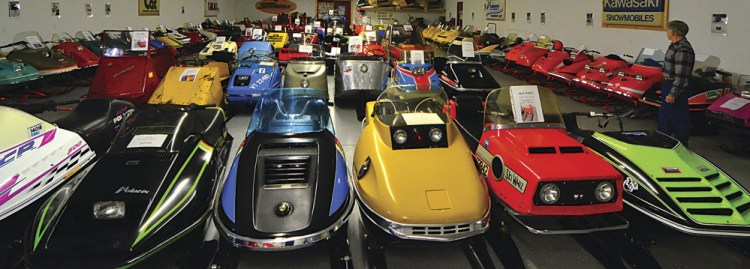LANCASTER, N.H. — For a small window of time, in the 1960s and ’70s, snowmobile racing was a big event that drew tens of thousands of people to Lancaster each year.
While those days are over, a new effort is underway to keep alive Lancaster’s heritage as the birthplace of snowmobile racing by honoring the first generation of racers and promoters through the new Eastern Snowmobile Racing Hall of Fame.
“They don’t recognize the people in the East for some reason and we wanted to honor our people, who should have been in there,” said Paul Crane, owner of Crane’s Snowmobile Museum in Lancaster.
Crane developed the hall of fame, which is located at the museum, with Lancaster resident Ed “Midge” Rosebrook, who suggested it.
It will recognize racers of the past in New Hampshire, Vermont, Maine, Massachusetts, and New York, with the goal to honor one promoter and three racers annually.
“We’re inducting the first generation of snowmobile racers, the guys who started it all,” said Rosebrook, who fell in love with snow machines while working on them for the town’s Polaris dealer.
The second round of inductees, in a ceremony scheduled for May 19 at the museum, are Lewis Lunn, of Massachusetts, who helped invent independent front suspension for snow machines; Ed Stabb, a promoter from New York; and racers Bruce Beauriveage, of Manchester and Pittsburg, and Calvin Reynolds, of Gorham, Maine.
In May of this year, the museum hosted the first induction ceremony of the Eastern Snowmobile Racing Hall Of Fame.
Honored then were racer/promoter Robert Clark, of Lancaster; racer Bruce Dunham, of Avon, Maine; racer Robert Martin, of Lancaster; and racer Conrad Rollins, of Abbott, Maine.
Their pictures and career highlights are framed in 8-by-10s on the museum wall.
The photographs of them were taken in their glory days. Rosebrook called them “snapshots in time, mud and all.”
“These guys were famous and it only happened for a short time,” he said of this year’s inductees and those to come.
The reason for the Eastern Snowmobile Racing Hall of Fame is because no early Eastern snowmobile racer this side of Lake Champlain has ever been inducted into the snowmobile hall of fame in Wisconsin, said Rosebrook.
A RICH PAST
Lancaster has a rich snowmobiling past.
In 1959, it debuted the revolutionary Bombardier Ski-Doo, the machine that helped launch a nationwide passion for snowmobiling and led to the rapid evolution of more streamlined snow machines.
Making that first Bombardier run was Crane, who in 2016 was inducted into the International Snowmobile Hall of Fame in St. Germain, Wisconsin.
The first organized “motorized toboggan” race in the U.S., an event Crane helped coordinate, was held in Lancaster in 1962.
In 1964, to coincide with the town’s bicentennial, the Lancaster Grand Prix, with its famous Kilkenny Cup, was born and became a big draw for racers and spectators across the Northeast, until it ended in 1977.
“Since then, there has been nothing in the winter time in the North Country that has brought so many people and has had so much impact,” Rosebrook said.
Rosebrook described the young men and women who began racing in the early 1960s.
“They were wearing knit hats, Johnson jackets and pants and green rubber barn boots,” he said. “They raced on sleds with little more than 10 horsepower. But in a few short years, they were wearing sled-matching race suits, full-face helmets and driving state-of-the-art ice-racing machines cranking out 100-plus horsepower and reaching top speeds of 100 mph.”
They also went from winning $2 trophies to winning thousands of dollars in prize money.
“Their names were in the headlines in every Monday morning newspaper across the snow belt,” Rosebrook said. “They were just ordinary small-town kids with a talent for going fast and who were suddenly put in the national spotlight.”
There were big names, he said, like Lancaster’s Bob Fortin, Bob Martin and Time White, Littleton’s Frank Dodge, and Maine’s Bruce Dunham and Cal Reynolds.
All of them wore top 10 numbered bibs while racing, and Dodge once wore Number 1.
“Big-time Eastern snowmobiling only lasted for a short time,” Rosebrook said.
“Maybe a tad over 15 years. But nothing in our long, cold winters since has even come close to the excitement or made as much of an impact as did snowmobile racing at its peak. The Grand Prix once drew over 20,000 fans.”
In 2010, Crane launched his museum to showcase vintage machines – there are 118 of them, including a 1920s Ford Model T specifically built for snow with a track and front skis – and recognize the first generation of Eastern racers who started it all.
The museum houses a sea of snow machines from a slew of makers, many that haven’t existed for decades.
Send questions/comments to the editors.


